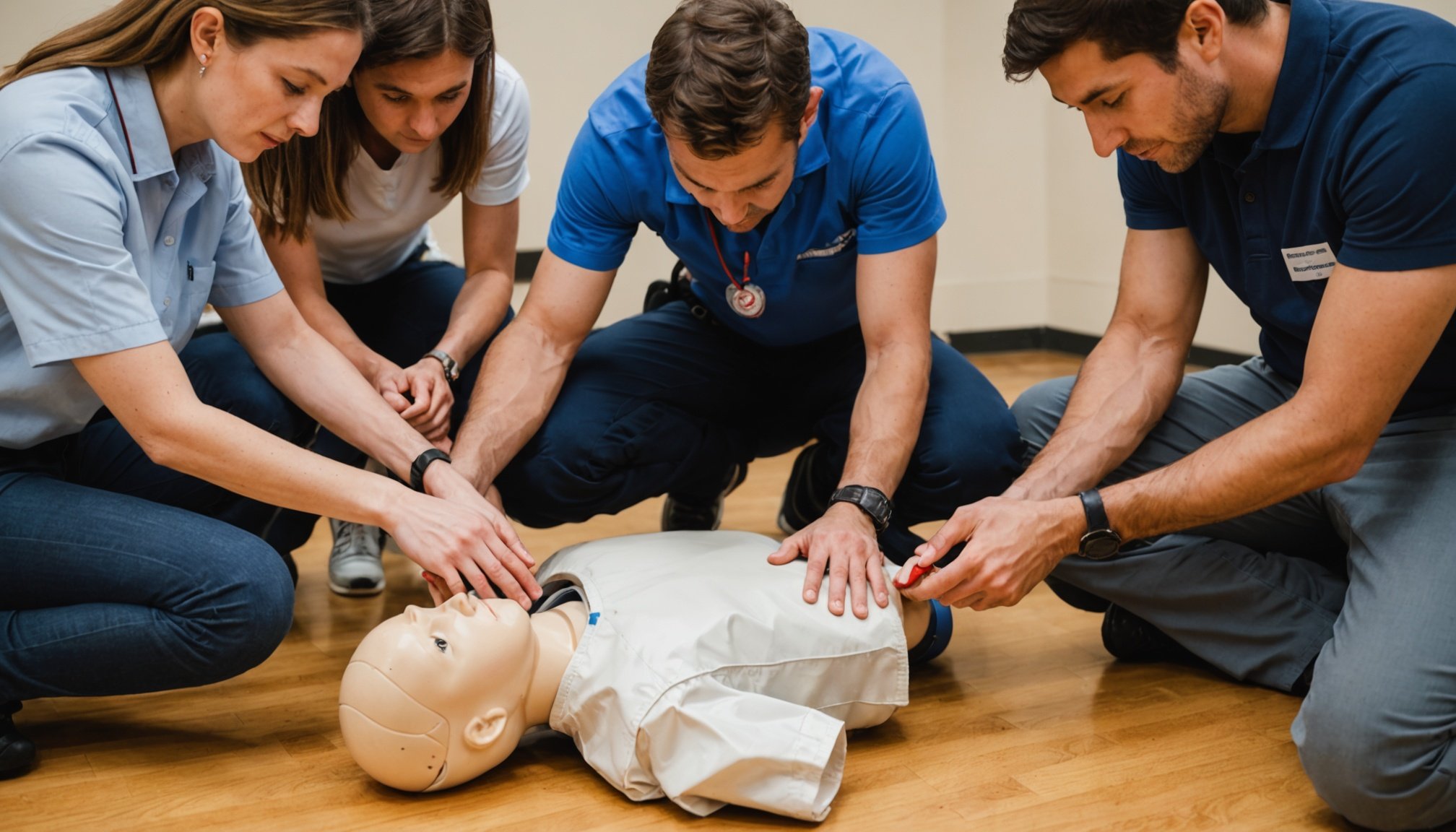Effective Techniques for Teaching Hands-Only CPR
Understanding Hands-Only CPR is crucial as it provides a simple, life-saving skill accessible to everyone. The technique comprises two core steps: call emergency services and push hard and fast in the centre of the chest. Simplification of CPR techniques ensures efficacy across diverse audiences, ranging from adults to school-age children.
Breaking down the process: place one hand over the other, interlock fingers, and maintain straight arms. Compress the chest at a depth of approximately two inches and aim for a rate of 100 to 120 compressions per minute. Public education strategies should focus on replicating the tempo of familiar tunes, like “Stayin’ Alive,” to aid in maintaining rhythm.
Topic to read : Cultivating Joy and Connection: The Mental Health Benefits of Community Gardening in Urban Areas
Teaching Hands-Only CPR effectively involves tailoring the delivery of information. Use relatable analogies or incorporate interactive activities to engage people of various learning levels. Visual aids, such as diagrams and videos, amplify understanding. By refining how CPR techniques are demonstrated, educators ensure that learners grasp essential actions quickly.
Public education strategies should prioritise empowering individuals, making them confident in emergency situations. Tailored approaches not only simplify complex concepts but also foster a community where everyone can respond and potentially save a life.
Also to see : Unlocking Peak Recovery: Top Techniques for ACL Rehab Success in Female Athletes
Resources for Educators and Trainers
Educators and trainers play a vital role in equipping individuals with life-saving CPR skills. To enhance teaching effectiveness, various resources offer structured support. Whether you’re preparing lessons or interactive training sessions, these resources are designed to improve knowledge transmission.
Lesson Plans
Comprehensive lesson plans provide a clear structure and timeline for CPR courses. These plans encompass step-by-step guides detailing the crucial aspects of Hands-Only CPR, ensuring educators remain focused during training.
Training Materials
Educational materials include visual aids and handouts to appeal to diverse learning styles. Resources like infographics and diagrams simplify complex concepts, improving learner comprehension and retention.
Online Resources
For remote education, digital tools and platforms offer invaluable support. These include virtual simulation software and video tutorials that provide interactive learning experiences. Online resources also facilitate the continuous learning journey, accommodating varying levels of accessibility.
By utilising these CPR teaching resources, educators can deliver improved and engaging training sessions, fostering a community ready to act competently in emergencies. Through structured lesson plans, tangible materials, and dynamic online tools, educators can elevate their teaching, ensuring students gain the confidence needed to perform effective CPR.
Engaging Presentation Tips
To deliver captivating CPR training, mastering your presentation skills is crucial. Engaging audiences requires strategies like starting with a compelling story. This emotional connection enhances retention and demonstrates CPR’s life-saving significance. By sharing real-life scenarios, trainers help audiences relate to the topic personally, fostering empathy and understanding.
Interactive elements further engage participants, making the session more memorable. Consider incorporating role-playing exercises or group discussions. These activities encourage public speaking for CPR trainers and boost audience involvement, effectively spreading these critical skills. Remember, interaction turns passive listeners into active learners.
Moreover, maintaining a dynamic presentation pace is key. Varying your speaking speed and tone can prevent monotony, ensuring your message remains impactful. Using visual aids like images or short videos can also further clarify and reinforce key points about Hands-Only CPR techniques.
Creating an inclusive environment in your training helps make everyone feel valued and involved. Tailor your approach based on the audience’s backgrounds or experience levels, allowing each participant to fully engage with the content. By focusing on these engaging audiences practices, your sessions will likely resonate deeply and effectively convey the importance of CPR knowledge.
Community Outreach Strategies
Building effective CPR community programs requires thoughtful outreach initiatives to engage diverse groups. Identifying target communities, particularly those with high-risk or underserved populations, is crucial. These groups benefit the most from increased access to CPR knowledge and training.
Collaborating with local organizations can magnify the impact of these programs. Partnering with schools, clubs, and civic groups can broaden reach and resources. Such collaborations often involve joint events and shared resources, enhancing community involvement and education.
Hosting community events and training sessions offers an engaging method to teach CPR. Events such as workshops and instructional sessions can be held in community centres, libraries, or even outdoor venues. This hands-on approach supports public understanding and application of CPR techniques in real-world scenarios.
Public engagement is also stimulated through media campaigns and social media platforms, which can publicize events and success stories from past outreach efforts. By effectively utilising these strategies, communities not only gain CPR proficiency but also nurture a culture of safety and preparedness. This community-focused approach ensures that more individuals are capable of taking life-saving actions during emergencies.
Success Stories from Past Campaigns
Exploring CPR success stories reveals the profound impact of effective campaigns on lifesaving efforts. Through detailed case studies, we can understand how structured programs have significantly enhanced CPR proficiency across different communities. For instance, a campaign in New York City led to a remarkable increase in public readiness, with over 1,000 new responders trained within three months.
Testimonials from individuals who have undergone CPR training often highlight a newfound confidence in handling emergencies. Such personal accounts serve as powerful motivators, showing how education not only equips individuals with skills but also empowers them to save lives. One trainee remarked, “The hands-on experience made me feel prepared to act decisively in real situations.”
Analyzing measurable outcomes, such as the rise in bystander CPR rates in urban areas, underscores the campaign’s effectiveness. Studies have correlated increased training initiatives with higher survival rates. Statistics reveal a 50% improvement in outcomes for cardiac arrest victims in communities with active public education strategies. These insights illustrate the tangible benefits of well-executed CPR training campaigns in making communities safer and more responsive to emergencies.
Practical Demonstrations for Ensuring Skill Proficiency
Hands-On Training in CPR is vital for developing confidence and capability. Conducting CPR demonstrations illuminates methods, ensuring learners can accurately replicate techniques. Practical application is not just about instruction; it engrains proficiency through repetitive practice.
Best practices for executing effective demonstrations involve breaking down each step clearly and sequentially. Start by demonstrating the correct positioning and the rhythm of compressions. Use feedback loops to reinforce learning—providing constructive critique encourages improvement. By repeatedly practicing under guidance, learners can internalise the rhythm and depth required for effective compressions.
CPR demonstrations benefit significantly from utilising real-life scenarios where participants can apply what they’ve learned in simulated emergency situations. This approach not only facilitates skill development but also builds crucial decision-making skills in high-pressure environments.
Incorporating interactive tools—such as manikins equipped with technology that provides real-time feedback on compression depth and rate—enhances the training experience. This practical engagement ensures that CPR techniques are not only learned but also retained, enhancing readiness for real incidents. Ultimately, embedding hands-on experiences within CPR education creates a robust foundation for lifesaving actions.
Statistical Insights on CPR Efficacy
Current CPR statistics reveal a compelling narrative about the critical role of this life-saving procedure. Especially noteworthy, survival rates after cardiac arrest can double or even triple when CPR techniques are promptly and effectively applied by bystanders.
Interestingly, research demonstrates that Hands-Only CPR, which eliminates mouth-to-mouth in favour of chest compressions, is just as effective in certain situations as traditional CPR. For example, a study found that continuous chest compressions significantly increase the chance of patient survival, particularly when initiated immediately.
Education plays a pivotal role in these outcomes. Communities with robust public education strategies in place invariably report higher incidences of bystander CPR participation. Increasing CPR proficiency directly correlates with improved emergency responses and ultimately better survival rates.
Moreover, ongoing research indicates that training more people in Hands-Only CPR could dramatically increase survival from out-of-hospital cardiac arrests. Such findings emphasize the value of CPR knowledge dissemination in both incremental and strategic manners. Each statistic underscores the message: informed, swift action saves lives, highlighting the significance of continued public education and innovative CPR programs.
Additional Resources for Further Training
To refine CPR skills further, explore CPR Training Resources that expand both competency and confidence. Continuous advancement in CPR knowledge enhances preparedness in emergencies.
Certification Programs
Obtaining a CPR certification is beneficial. Choose from reputable programs like those offered by the American Heart Association or British Red Cross. Certification not only validates your expertise but also ensures you stay current with techniques.
Workshops and Seminars
Attending workshops and seminars provides avenues for professional development. These events offer hands-on experiences, where networking with fellow trainees enriches learning through shared insights. Participants engage in practical exercises, enhancing skill proficiency.
Online Courses
Online options for continuous learning abound. Utilize digital platforms like Coursera or edX, which offer self-paced learning modules. These courses accommodate varied schedules and allow for revisiting material as needed.
Incorporating these resources into your learning journey ensures a comprehensive understanding of CPR. Whether through rigorous certification programs, interactive workshops, or flexible online courses, these tools foster a well-rounded grasp of life-saving skills, promoting readiness and efficiency when it matters most.





